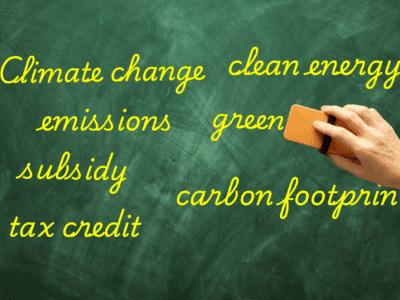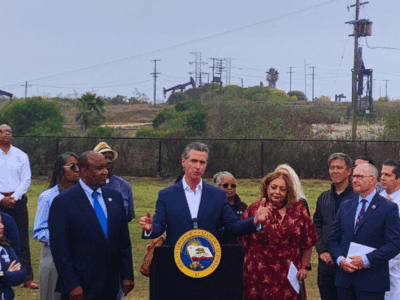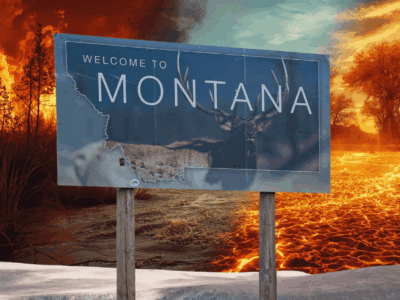California
A Full-Court Press on Methane, Climate in the Governor’s Race
The Drain is a weekly roundup of environmental and climate news from Legal Planet.
Replacing high-carbon fossil fuels with clean energy while also adapting to climate change — that’s the ballgame. But we may not get to the ninth inning in one piece if we don’t deal with methane first. That’s one takeaway from the COP30 UN climate summit. Pick your metaphor — and there are many — but …
Continue reading “A Full-Court Press on Methane, Climate in the Governor’s Race”
CONTINUE READINGGood COP, Bad COP in Belém, Brazil
The Drain is a weekly roundup of environmental and climate news from Legal Planet.
The United Nations mega-conference focused on climate change known as COP (“Conference of the Parties”) is well underway in Belém, Brazil with 193 countries plus the EU, 57 heads of state, 39 ministers and hundreds of governors, mayors, and local officials participating. Two of my UCLA Law colleagues are on the ground in Belém this …
Continue reading “Good COP, Bad COP in Belém, Brazil “
CONTINUE READINGAt a Loss for Words? Resist Climate Silence
The Drain is a weekly roundup of environmental and climate news from Legal Planet.
A few years ago, I was writing about how President Joe Biden was flying around the country to promote his landmark climate law without uttering the word “climate.” Seems so quaint. Now, we find ourselves in a place where “climate change” is on a list of banned words maintained by the U.S. Energy Department, along …
Continue reading “At a Loss for Words? Resist Climate Silence”
CONTINUE READINGCalifornia Takes a Stab at Climate and Energy Costs
The Drain is a weekly roundup of environmental and climate news from Legal Planet.
It’s remarkable that with everything else that’s raging, climate and energy bills still managed to dominate the legislative session that just wrapped in Sacramento. After all, the reason lawmakers were still at work this past Saturday — the day after the legislative session was supposed to end — was that negotiations on climate bills pushed …
Continue reading “California Takes a Stab at Climate and Energy Costs”
CONTINUE READINGCalifornia Must Invest in Climate and Communities to Drive Climate Progress
The state has pioneered an approach—what’s worked, and what’s next?
As solar and other climate infrastructure construction accelerates, and with Californians concerned both about the cost of living and about seeing local opportunities result from climate projects, the conversation about community benefits (commitments to hiring and other local investments made by developers in connection with new projects) has grown increasingly animated in California and even …
Continue reading “California Must Invest in Climate and Communities to Drive Climate Progress”
CONTINUE READINGYoung Climate Plaintiffs Won Big in Montana. Can They Again?
The Drain is a weekly roundup of environmental and climate news from Legal Planet.
One of the biggest climate victories to date belongs to 19-year-old Eva Lighthiser and the other Montana youth climate plaintiffs who won their landmark case against state officials and saw it upheld in the state Supreme Court. Now, some of those same young people — Lighthiser included — are headed back to court next week …
Continue reading “Young Climate Plaintiffs Won Big in Montana. Can They Again?”
CONTINUE READINGTrump’s War on Wind is Dumb. It also Makes Sense.
The Drain is a weekly roundup of environmental and climate news from Legal Planet.
The Trump administration’s attack on wind energy feels dumber and dumber every day. Let’s see if we can make it make some sense. After that, the major headlines of the week. Last Friday, his Transportation Department withdrew $679 million for offshore wind projects at 12 ports. Last month, the administration sent a stop-work order to …
Continue reading “Trump’s War on Wind is Dumb. It also Makes Sense.”
CONTINUE READINGStates Should Not Wait to “Make Polluters Pay”
Guest contributors Laura Fox and Doug Kysar write that now is the right time for more states to adopt climate accountability laws, despite ongoing legal challenges.
As states weigh whether to adopt climate accountability legislation like Vermont’s Climate Superfund Act, some are hesitating out of concern that the Second Circuit’s decision in City of New York v. Chevron Corp., 993 F.3d 81 (2d Cir. 2021), dooms such efforts. That concern is misplaced. In fact, now is precisely the time for states …
Continue reading “States Should Not Wait to “Make Polluters Pay””
CONTINUE READINGFrom Sacramento to Geneva: Two Arenas Tackle Plastic Pollution
California considers adding microplastics to its Candidate Chemical List as delegates negotiate a Global Binding Treaty on Plastics in Switzerland
Last Monday, the California Department of Toxic Substances Control (DTSC) closed its public comment period on a proposal to add microplastics to its Candidate Chemicals List. Adding microplastics to this list would allow the State’s Safer Consumer Product Program to evaluate potential Priority Products that may contain or release microplastics. The Program works to make …
Continue reading “From Sacramento to Geneva: Two Arenas Tackle Plastic Pollution”
CONTINUE READINGChina is Kicking Our Ass at Our Own Game
The Drain is a weekly roundup of environmental and climate news from Legal Planet.
The first time I saw a Chinese-made EV on the road I was walking on a crowded sidewalk in São Paulo. It was a Saturday night this May, when the whole city seemed to be out enjoying the warm weather. A street rave took over an entire block so to keep moving, we pedestrians had …
Continue reading “China is Kicking Our Ass at Our Own Game”
CONTINUE READING












